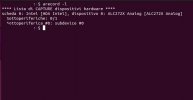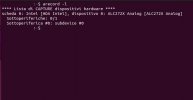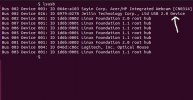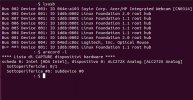vertifor922
Member
Here's what the terminal returns before and after connecting the camera, I think I've located the camera and indicated it with a white arrow.
Below everything that is returned by the LIBGL_ALWAYS_SOFTWARE=1 obs command that I use to start Obs
$ LIBGL_ALWAYS_SOFTWARE=1 obs
Warning: Ignoring WAYLAND_DISPLAY on Gnome. Use QT_QPA_PLATFORM=wayland to run on Wayland anyway.
debug: Found portal inhibitor
debug: Attempted path: share/obs/obs-studio/locale/en-US.ini
debug: Attempted path: /usr/share/obs/obs-studio/locale/en-US.ini
debug: Attempted path: share/obs/obs-studio/locale.ini
debug: Attempted path: /usr/share/obs/obs-studio/locale.ini
debug: Attempted path: share/obs/obs-studio/locale/it-IT.ini
debug: Attempted path: /usr/share/obs/obs-studio/locale/it-IT.ini
info: Using preferred locale 'it-IT'
debug: Attempted path: share/obs/obs-studio/themes/Yami.qss
debug: Attempted path: /usr/share/obs/obs-studio/themes/Yami.qss
info: Using EGL/X11
info: CPU Name: Celeron(R) Dual-Core CPU T3100 @ 1.90GHz
info: CPU Speed: 1895.226MHz
info: Physical Cores: 2, Logical Cores: 2
info: Physical Memory: 3853MB Total, 615MB Free
info: Kernel Version: Linux 5.15.0-58-generic
info: Distribution: "Ubuntu" "22.04"
info: Session Type: wayland
info: Window System: X11.0, Vendor: The X.Org Foundation, Version: 1.22.1
info: Qt Version: 6.2.4 (runtime), 6.2.4 (compiled)
info: Portable mode: false
qt.core.qmetaobject.connectslotsbyname: QMetaObject::connectSlotsByName: No matching signal for on_tbar_position_valueChanged(int)
info: OBS 29.0.2 (linux)
info: ---------------------------------
info: ---------------------------------
info: audio settings reset:
samples per sec: 48000
speakers: 2
max buffering: 960 milliseconds
buffering type: dynamically increasing
info: ---------------------------------
info: Initializing OpenGL...
info: Loading up OpenGL on adapter Mesa/X.org llvmpipe (LLVM 15.0.6, 128 bits)
info: OpenGL loaded successfully, version 4.5 (Core Profile) Mesa 22.2.5, shading language 4.50
info: ---------------------------------
info: video settings reset:
base resolution: 1360x768
output resolution: 848x480
downscale filter: Bicubic
fps: 30/1
format: NV12
YUV mode: Rec. 709/Partial
info: NV12 texture support not available
info: P010 texture support not available
info: Audio monitoring device:
name: Predefinito
id: default
info: ---------------------------------
warning: No AJA devices found, skipping loading AJA UI plugin
warning: Failed to initialize module 'aja-output-ui.so'
warning: No AJA devices found, skipping loading AJA plugin
warning: Failed to initialize module 'aja.so'
warning: Failed to load 'en-US' text for module: 'decklink-captions.so'
warning: Failed to load 'en-US' text for module: 'decklink-output-ui.so'
libDeckLinkAPI.so: impossibile aprire il file oggetto condiviso: File o directory non esistente
warning: A DeckLink iterator could not be created. The DeckLink drivers may not be installed
warning: Failed to initialize module 'decklink.so'
info: [pipewire] Available captures:
info: [pipewire] - Desktop capture
info: [pipewire] - Window capture
info: [obs-browser]: Version 2.19.0
info: [obs-browser]: CEF Version 103.0.5060.134 (runtime), 103.0.0-5060-shared-textures_143.2591+g4204d54+chromium-103.0.5060.134 (compiled)
info: VAAPI: API version 1.14
info: FFmpeg VAAPI H264 encoding not supported
info: [obs-websocket] [obs_module_load] you can haz websockets (Version: 5.1.0 | RPC Version: 1)
info: [obs-websocket] [obs_module_load] Qt version (compile-time): 6.2.4 | Qt version (run-time): 6.2.4
info: [obs-websocket] [obs_module_load] Linked ASIO Version: 101201
info: [obs-websocket] [obs_module_load] Module loaded.
error: os_dlopen(libvlc.so.5->libvlc.so.5): libvlc.so.5: impossibile aprire il file oggetto condiviso: File o directory non esistente
info: [vlc-video]: Couldn't find VLC installation, VLC video source disabled
info: ---------------------------------
info: Loaded Modules:
info: vlc-video.so
info: text-freetype2.so
info: rtmp-services.so
info: obs-x264.so
info: obs-websocket.so
info: obs-vst.so
info: obs-transitions.so
info: obs-outputs.so
info: obs-libfdk.so
info: obs-filters.so
info: obs-ffmpeg.so
info: obs-browser.so
info: linux-v4l2.so
info: linux-pulseaudio.so
info: linux-pipewire.so
info: linux-jack.so
info: linux-capture.so
info: linux-alsa.so
info: image-source.so
info: frontend-tools.so
info: decklink-output-ui.so
info: decklink-captions.so
info: ---------------------------------
QLayout: Attempting to add QLayout "" to OBSBasic "OBSBasic", which already has a layout
QWidget::setTabOrder: 'first' and 'second' must be in the same window
info: ==== Startup complete ===============================================
info: All scene data cleared
info: ------------------------------------------------
info: pulse-input: Server name: 'pulseaudio 15.99.1'
info: pulse-input: Audio format: s16le, 44100 Hz, 2 channels
info: pulse-input: Started recording from 'alsa_output.pci-0000_00_1b.0.analog-stereo.monitor' (default)
info: pulse-am: Prevented feedback-loop in 'default'
info: [Loaded global audio device]: 'Audio del desktop'
info: - monitoring: monitor and output
info: pulse-input: Server name: 'pulseaudio 15.99.1'
info: pulse-input: Audio format: s16le, 44100 Hz, 2 channels
info: pulse-input: Started recording from 'alsa_output.pci-0000_00_1b.0.analog-stereo.monitor' (default)
info: pulse-am: Prevented feedback-loop in 'default'
info: [Loaded global audio device]: 'Audio del desktop 2'
info: - monitoring: monitor and output
info: pulse-input: Server name: 'pulseaudio 15.99.1'
info: pulse-input: Audio format: s16le, 44100 Hz, 2 channels
info: pulse-input: Started recording from 'alsa_input.pci-0000_00_1b.0.analog-stereo' (default)
info: pulse-am: Server name: 'pulseaudio 15.99.1'
info: pulse-am: Audio format: s16le, 44100 Hz, 2 channels
info: pulse-am: Started Monitoring in 'alsa_output.pci-0000_00_1b.0.analog-stereo.monitor'
info: [Loaded global audio device]: 'Microfono/disp. ausiliario'
info: - monitoring: monitor and output
info: pulse-input: Server name: 'pulseaudio 15.99.1'
info: pulse-input: Audio format: s16le, 44100 Hz, 2 channels
info: pulse-input: Started recording from 'alsa_input.pci-0000_00_1b.0.analog-stereo'
info: pulse-am: Server name: 'pulseaudio 15.99.1'
info: pulse-am: Audio format: s16le, 44100 Hz, 2 channels
info: pulse-am: Started Monitoring in 'alsa_output.pci-0000_00_1b.0.analog-stereo.monitor'
info: [Loaded global audio device]: 'Microfono/disp. ausiliario 2'
info: - monitoring: monitor and output
info: pulse-input: Server name: 'pulseaudio 15.99.1'
info: pulse-input: Audio format: s16le, 44100 Hz, 2 channels
info: pulse-input: Started recording from 'alsa_input.pci-0000_00_1b.0.analog-stereo'
info: pulse-am: Server name: 'pulseaudio 15.99.1'
info: pulse-am: Audio format: s16le, 44100 Hz, 2 channels
info: pulse-am: Started Monitoring in 'alsa_output.pci-0000_00_1b.0.analog-stereo.monitor'
info: [Loaded global audio device]: 'Microfono/disp. ausiliario 3'
info: - monitoring: monitor and output
info: pulse-input: Server name: 'pulseaudio 15.99.1'
info: pulse-input: Audio format: s16le, 44100 Hz, 2 channels
info: pulse-input: Started recording from 'alsa_input.pci-0000_00_1b.0.analog-stereo'
info: [Loaded global audio device]: 'Microfono/disp. ausiliario 4'
info: alsa-input: PCM 'default' rate set to 44100
info: alsa-input: PCM 'default' channels set to 2
info: Switched to scene 'Scena 2'
info: ------------------------------------------------
info: Loaded scenes:
info: - scene 'Scena 2':
info: - source: 'Dispositivo di acquisizione audio (ALSA)' (alsa_input_capture)
info: ------------------------------------------------
info: adding 42 milliseconds of audio buffering, total audio buffering is now 42 milliseconds (source: Microfono/disp. ausiliario)
Below everything that is returned by the LIBGL_ALWAYS_SOFTWARE=1 obs command that I use to start Obs
$ LIBGL_ALWAYS_SOFTWARE=1 obs
Warning: Ignoring WAYLAND_DISPLAY on Gnome. Use QT_QPA_PLATFORM=wayland to run on Wayland anyway.
debug: Found portal inhibitor
debug: Attempted path: share/obs/obs-studio/locale/en-US.ini
debug: Attempted path: /usr/share/obs/obs-studio/locale/en-US.ini
debug: Attempted path: share/obs/obs-studio/locale.ini
debug: Attempted path: /usr/share/obs/obs-studio/locale.ini
debug: Attempted path: share/obs/obs-studio/locale/it-IT.ini
debug: Attempted path: /usr/share/obs/obs-studio/locale/it-IT.ini
info: Using preferred locale 'it-IT'
debug: Attempted path: share/obs/obs-studio/themes/Yami.qss
debug: Attempted path: /usr/share/obs/obs-studio/themes/Yami.qss
info: Using EGL/X11
info: CPU Name: Celeron(R) Dual-Core CPU T3100 @ 1.90GHz
info: CPU Speed: 1895.226MHz
info: Physical Cores: 2, Logical Cores: 2
info: Physical Memory: 3853MB Total, 615MB Free
info: Kernel Version: Linux 5.15.0-58-generic
info: Distribution: "Ubuntu" "22.04"
info: Session Type: wayland
info: Window System: X11.0, Vendor: The X.Org Foundation, Version: 1.22.1
info: Qt Version: 6.2.4 (runtime), 6.2.4 (compiled)
info: Portable mode: false
qt.core.qmetaobject.connectslotsbyname: QMetaObject::connectSlotsByName: No matching signal for on_tbar_position_valueChanged(int)
info: OBS 29.0.2 (linux)
info: ---------------------------------
info: ---------------------------------
info: audio settings reset:
samples per sec: 48000
speakers: 2
max buffering: 960 milliseconds
buffering type: dynamically increasing
info: ---------------------------------
info: Initializing OpenGL...
info: Loading up OpenGL on adapter Mesa/X.org llvmpipe (LLVM 15.0.6, 128 bits)
info: OpenGL loaded successfully, version 4.5 (Core Profile) Mesa 22.2.5, shading language 4.50
info: ---------------------------------
info: video settings reset:
base resolution: 1360x768
output resolution: 848x480
downscale filter: Bicubic
fps: 30/1
format: NV12
YUV mode: Rec. 709/Partial
info: NV12 texture support not available
info: P010 texture support not available
info: Audio monitoring device:
name: Predefinito
id: default
info: ---------------------------------
warning: No AJA devices found, skipping loading AJA UI plugin
warning: Failed to initialize module 'aja-output-ui.so'
warning: No AJA devices found, skipping loading AJA plugin
warning: Failed to initialize module 'aja.so'
warning: Failed to load 'en-US' text for module: 'decklink-captions.so'
warning: Failed to load 'en-US' text for module: 'decklink-output-ui.so'
libDeckLinkAPI.so: impossibile aprire il file oggetto condiviso: File o directory non esistente
warning: A DeckLink iterator could not be created. The DeckLink drivers may not be installed
warning: Failed to initialize module 'decklink.so'
info: [pipewire] Available captures:
info: [pipewire] - Desktop capture
info: [pipewire] - Window capture
info: [obs-browser]: Version 2.19.0
info: [obs-browser]: CEF Version 103.0.5060.134 (runtime), 103.0.0-5060-shared-textures_143.2591+g4204d54+chromium-103.0.5060.134 (compiled)
info: VAAPI: API version 1.14
info: FFmpeg VAAPI H264 encoding not supported
info: [obs-websocket] [obs_module_load] you can haz websockets (Version: 5.1.0 | RPC Version: 1)
info: [obs-websocket] [obs_module_load] Qt version (compile-time): 6.2.4 | Qt version (run-time): 6.2.4
info: [obs-websocket] [obs_module_load] Linked ASIO Version: 101201
info: [obs-websocket] [obs_module_load] Module loaded.
error: os_dlopen(libvlc.so.5->libvlc.so.5): libvlc.so.5: impossibile aprire il file oggetto condiviso: File o directory non esistente
info: [vlc-video]: Couldn't find VLC installation, VLC video source disabled
info: ---------------------------------
info: Loaded Modules:
info: vlc-video.so
info: text-freetype2.so
info: rtmp-services.so
info: obs-x264.so
info: obs-websocket.so
info: obs-vst.so
info: obs-transitions.so
info: obs-outputs.so
info: obs-libfdk.so
info: obs-filters.so
info: obs-ffmpeg.so
info: obs-browser.so
info: linux-v4l2.so
info: linux-pulseaudio.so
info: linux-pipewire.so
info: linux-jack.so
info: linux-capture.so
info: linux-alsa.so
info: image-source.so
info: frontend-tools.so
info: decklink-output-ui.so
info: decklink-captions.so
info: ---------------------------------
QLayout: Attempting to add QLayout "" to OBSBasic "OBSBasic", which already has a layout
QWidget::setTabOrder: 'first' and 'second' must be in the same window
info: ==== Startup complete ===============================================
info: All scene data cleared
info: ------------------------------------------------
info: pulse-input: Server name: 'pulseaudio 15.99.1'
info: pulse-input: Audio format: s16le, 44100 Hz, 2 channels
info: pulse-input: Started recording from 'alsa_output.pci-0000_00_1b.0.analog-stereo.monitor' (default)
info: pulse-am: Prevented feedback-loop in 'default'
info: [Loaded global audio device]: 'Audio del desktop'
info: - monitoring: monitor and output
info: pulse-input: Server name: 'pulseaudio 15.99.1'
info: pulse-input: Audio format: s16le, 44100 Hz, 2 channels
info: pulse-input: Started recording from 'alsa_output.pci-0000_00_1b.0.analog-stereo.monitor' (default)
info: pulse-am: Prevented feedback-loop in 'default'
info: [Loaded global audio device]: 'Audio del desktop 2'
info: - monitoring: monitor and output
info: pulse-input: Server name: 'pulseaudio 15.99.1'
info: pulse-input: Audio format: s16le, 44100 Hz, 2 channels
info: pulse-input: Started recording from 'alsa_input.pci-0000_00_1b.0.analog-stereo' (default)
info: pulse-am: Server name: 'pulseaudio 15.99.1'
info: pulse-am: Audio format: s16le, 44100 Hz, 2 channels
info: pulse-am: Started Monitoring in 'alsa_output.pci-0000_00_1b.0.analog-stereo.monitor'
info: [Loaded global audio device]: 'Microfono/disp. ausiliario'
info: - monitoring: monitor and output
info: pulse-input: Server name: 'pulseaudio 15.99.1'
info: pulse-input: Audio format: s16le, 44100 Hz, 2 channels
info: pulse-input: Started recording from 'alsa_input.pci-0000_00_1b.0.analog-stereo'
info: pulse-am: Server name: 'pulseaudio 15.99.1'
info: pulse-am: Audio format: s16le, 44100 Hz, 2 channels
info: pulse-am: Started Monitoring in 'alsa_output.pci-0000_00_1b.0.analog-stereo.monitor'
info: [Loaded global audio device]: 'Microfono/disp. ausiliario 2'
info: - monitoring: monitor and output
info: pulse-input: Server name: 'pulseaudio 15.99.1'
info: pulse-input: Audio format: s16le, 44100 Hz, 2 channels
info: pulse-input: Started recording from 'alsa_input.pci-0000_00_1b.0.analog-stereo'
info: pulse-am: Server name: 'pulseaudio 15.99.1'
info: pulse-am: Audio format: s16le, 44100 Hz, 2 channels
info: pulse-am: Started Monitoring in 'alsa_output.pci-0000_00_1b.0.analog-stereo.monitor'
info: [Loaded global audio device]: 'Microfono/disp. ausiliario 3'
info: - monitoring: monitor and output
info: pulse-input: Server name: 'pulseaudio 15.99.1'
info: pulse-input: Audio format: s16le, 44100 Hz, 2 channels
info: pulse-input: Started recording from 'alsa_input.pci-0000_00_1b.0.analog-stereo'
info: [Loaded global audio device]: 'Microfono/disp. ausiliario 4'
info: alsa-input: PCM 'default' rate set to 44100
info: alsa-input: PCM 'default' channels set to 2
info: Switched to scene 'Scena 2'
info: ------------------------------------------------
info: Loaded scenes:
info: - scene 'Scena 2':
info: - source: 'Dispositivo di acquisizione audio (ALSA)' (alsa_input_capture)
info: ------------------------------------------------
info: adding 42 milliseconds of audio buffering, total audio buffering is now 42 milliseconds (source: Microfono/disp. ausiliario)




